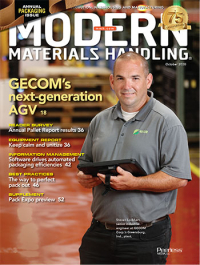Stretch Wrap and Strap Packaging: Keep calm and unitize
Stretch wrap and strapping are the two leaders when it comes to keeping loads safe and secure. Both are undergoing some changes that will make it easier to carry on even as more is expected of unitized pallet loads.
Before any item in the supply chain becomes an each, it was part of a pallet load. That goes for everything from headphones to bricks. And, every one of those pallet loads must be unitized securely as it travels to its destination. Otherwise, way too many damaged eaches can never be sold to you or the construction site down the street.
That’s where stretch wrap, strapping and stretch hoods enter the picture. All three are undergoing some shifts that will reduce your labor needs, increase throughput in the packaging department and improve the security and protection of unitized loads.
Just ask Pat Lancaster, chairman and founder of Lantech, about leading trends in unitizing loads.
“Covid is a monster,” says Lancaster. “It’s at least tripling the stimulus that is driving the shift to ramp up production as quickly as possible. It doesn’t matter if you’re talking paper products, bottled water, health and beauty aids or food. All are under tremendous pressure. It’s almost a frantic push.”
More interest in automation
So, how do you accelerate the unitizing process?
Automation is the key word, whether you talk to Lancaster, John Rometty of Signode or Sebastian Titze of Beumer. Interestingly, manual strapping and stretch wrapping have long had a notable presence for a range of products. And both manual unitizing modes are now getting a close review—and for good reasons.
Rometty, director of Signode’s equipment sales for the Americas, explains that hand strapping accounts for less than 5% of lumber products, but more than 90% of items shipped from metal service centers. “The application itself has traditionally influenced the use of hand strapping,” he adds. “However, many companies in a range of industries want to shift to automation. This will create a permanent shift in how companies strap.”
Lancaster is even more forceful about stretch wrapping. “Hand wrapping is the worst job in the factory. And, hand wrapping accounts for 30% of all stretch wrapped loads,” he says. “Imagine being bent over, holding two milk bottles, one in each hand, close to the ground, and backing up in a circle 18 times pulling 15 pounds of weight. Now do that wearing a mask and being socially distanced…”
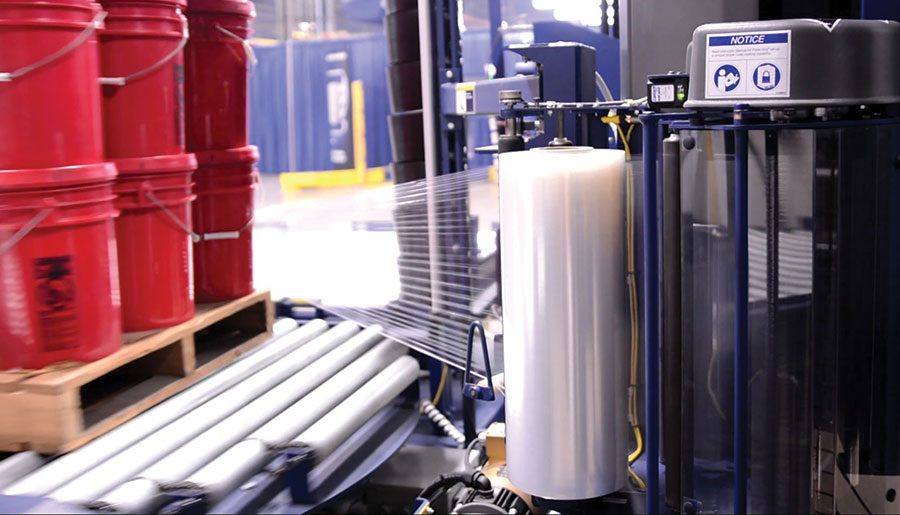
Automation eliminates hand wrapping, often described as “the worst job in the factory.”
That’s tough to unsee. It’s also a job most people don’t want. And, it doesn’t matter whether the load is stretch wrapped or strapped by hand. Neither is an ideal situation.
Which brings up the importance of automation to reduce labor issues in the packaging department. The move from hand work to automation greatly reduces the pressure to find people for less than desirable jobs. There’s also the matter of accommodating staffing issues due to potential Covid outbreaks and other factors that require people to work in multiple departments. The strain on training here is not to be underestimated, say the experts.
As a result, says Lancaster, hand wrapping is one of the first areas being considered for automation. And, there’s great potential here, he adds. “Almost half of hand wrapping is in large companies that typically have the interest and dollars to automate.”
With stretch wrap in particular, several options are available when it comes to automation. There are semi-automatic wrappers as well as fully automated machines. According to Lantech, stretch wrapping 400 loads a week with a semi-automatic machine saves 7 hours of labor compared to hand wrapping. Over the course of a year, that’s a dollar savings of 364 times your hourly worker rate.
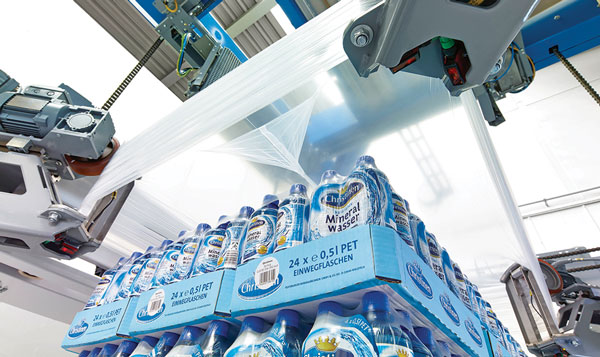
It’s worth noting here that another form of automated load wrapping is getting new interest these days. As Titze, business development and strategy manager at Beumer, explains, stretch hooding is a highly automated cousin of traditional stretch wrap that can boost throughput at least 10% to 20%. And while Beumer has been in that business for awhile, Rometty says Signode is pushing into it for the first time as you read this. Details later.
The latest in strapping
As it turns out, strapping has been undergoing its own organic shift lately. Traditionally, steel strapping dominated. And, it still accounts for about 65% of strapping applications. But plastic PET strapping has established itself in about 25% of applications as a more economical, high-performance alternative.
Now, the shift didn’t happen overnight, says Rometty. It required extensive testing of PET strapping to ensure it met standards for various industries. One of the key ones here is railroad shipping of bricks and lumber. That said, Rometty says hot coil metal applications will never move to PET for obvious reasons. However, cool aluminum ingots and similar metal products benefit from PET strapping, which does not have sharp edges as does slit steel.
One success story here, says Rometty, is the use of high-strength PET strapping for brick loads. For instance, modular strapping heads fully integrated with a leading brick supplier’s packaging line accommodate 20% faster production speeds that account for more than a $100,000 annual labor savings. The equipment, says Rometty, trimmed equipment downtime in half while increasing strap placement accuracy, ensuring a more secure load weighing as much as 2,000 pounds.
At the same time, we’re seeing improvements in hand strapping tools, too. “Because of the force required to strap a load, there is great strain on the tool’s battery,” explains Rometty. The Grip Pak tools have an efficient design that allows them to overcome the forces needed to operate with battery power. This results in more than 120 cycles per battery charge.
And while most people focus on unitizing loads moving from the factory to distribution centers, securing loads within the facility is also important. As John Kuhn, vice president of sales for Aero Rubber Co., explains, that’s the sweet spot for rubberized pallet bands.
He says these elastomer bands range in circumference from 56 to 128 inches and are ¾ to 1.5 inches wide. “It only takes a few seconds to secure a load with pallet bands compared to minutes for stretch wrap,” adds Kuhn.
Bands are placed either midway or at the top of loads to secure loads ranging from barrels to corrugated cartons. Bands are not recommended for LTL shipments, but are effective for transporting loads within a facility or between facilities located close to each other.
Unlike stretch wrap, says Kuhn, pallet bands can be reused at least 10 times. That reduces cost per use and greatly minimizes trash accumulation.
Advances in stretch wrap
The push with stretch wrapper machines is to make the machine smarter, says Lancaster. Not only does that improve stretch wrapper efficiencies, but it typically reduces the interaction needed between staff and the equipment.
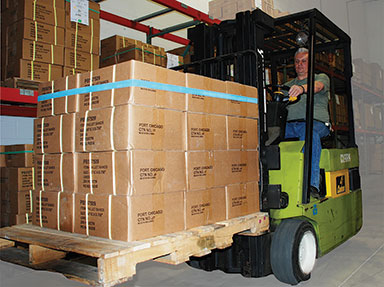 For instance, Load Guardian is Lantech’s patented control system that regulates the force applied to the load during wrapping. This ensures the load is properly contained regardless of any irregularities in the shape. For instance, light, stable loads such as paper towels require 2 to 5 pounds of force while heavy, unstable loads such as water bottles require 12 to 20 pounds of containment force. The system also ensures the wrap is locked to the pallet without dragging film tails.
For instance, Load Guardian is Lantech’s patented control system that regulates the force applied to the load during wrapping. This ensures the load is properly contained regardless of any irregularities in the shape. For instance, light, stable loads such as paper towels require 2 to 5 pounds of force while heavy, unstable loads such as water bottles require 12 to 20 pounds of containment force. The system also ensures the wrap is locked to the pallet without dragging film tails.
In addition, Load Guardian monitors performance of the machine. Measured metrics include total machine cycles, wrap time per load, film used and containment force applied, to name a few. The monitor develops a performance audit for a given period of time, allowing an assessment of performance and potential maintenance requirements. “This allows the user to manage to exception,” says Lancaster.
Stretch hooding on the rise
As Titze of Beumer explains, stretch hooding has been around since the late 1980s, yet is relatively unknown. “We spend a lot of time educating people on what it is and how it is a highly automated cousin of conventional stretch wrapping. Stretch hooding also has some advantages,” he says.
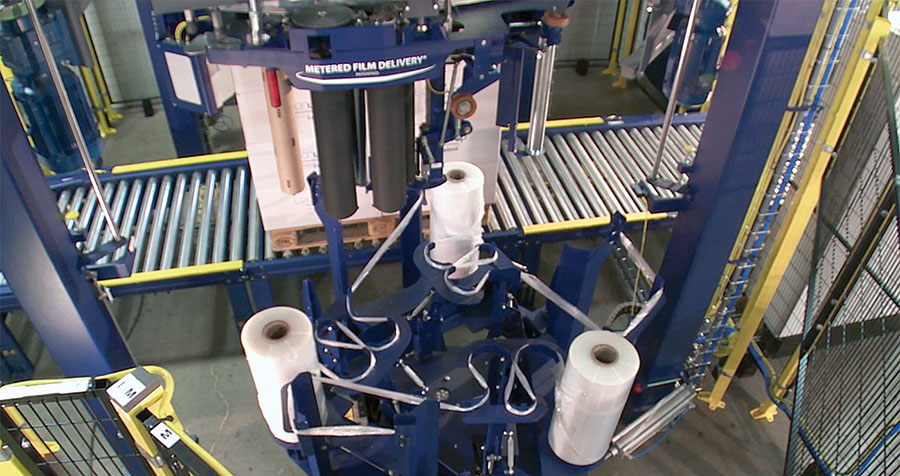
Stretch wrap control systems monitor the force applied to the film during application, tailoring stretch tension to the load.
You could say stretch hooding brings a different orientation to unitizing a pallet load. While stretch wrap secures a load laterally, stretch hooding pulls a film sock over the load from the top down. As it’s pulled down, the film stretches over the load, tightly securing it to the pallet without heat. Titze says this creates vertical film forces that keep the load close to the pallet even when tilted or pushed sideways. Typically, 30% less film is required compared to stretch wrapping.
The unitized load is protected on five of its six sides with the pallet serving as protection on the final side. Weather protection is excellent with no gaps or openings, common with hand stretch wrap in particular. Film clarity is also excellent, allowing company logos and other branding to be printed on the film. It is also easy to read bar codes through the film.
Stretch hooding is faster than stretch wrapping, typically wrapping 200 pallets an hour compared to 150 for stretch wrapping, says Titze. Leading applications include food and beverage and consumer electronics as well as roofing materials and even cement.
Signode also offers stretch hooding and says its equipment can unitize up to 250 loads an hour, says Rometty. “While typically more expensive than conventional automatic stretch wrapping equipment, stretch hooding easily justifies itself in less than three years,” Rometty adds.
In addition to the applications already mentioned, Rometty says stretch hooding is a candidate for certain applications currently using a hybrid solution. For instance, Cargill uses adhesive and stretch wrap to unitize 50-pound bags of malt grain for craft beer and whiskey production. The stretch hooding solution reduces cycle time by 50% while saving 30% in film consumption. In addition, stretch hooding provides superior moisture and weather resistance, a major benefit to the bags of malt grain.
In short, unitizing is continuing to evolve, offering advanced efficiencies and cost savings to pallet load shipments.
Companies mentioned in this article:

Article Topics
Automation News & Resources
Beckhoff USA opens new office in Austin, Texas ASME Foundation wins grant for technical workforce development Walmart chooses Swisslog AS/RS and software for third milk processing facility Lucas Watson appointed CSO for Körber’s Parcel Logistics business in North America 60 Seconds with Bob Trebilcock, outgoing executive editor, Modern Materials Handling Kathleen Phelps to join FORTNA as chief financial officer Coles automates grocery distribution in Australia More AutomationLatest in Materials Handling
Beckhoff USA opens new office in Austin, Texas Manhattan Associates selects TeamViewer as partner for warehouse vision picking ASME Foundation wins grant for technical workforce development The (Not So) Secret Weapons: How Key Cabinets and Asset Management Lockers Are Changing Supply Chain Operations MODEX C-Suite Interview with Harold Vanasse: The perfect blend of automation and sustainability Consultant and industry leader John M. Hill passes on at age 86 Registration open for Pack Expo International 2024 More Materials HandlingSubscribe to Materials Handling Magazine

Find out what the world's most innovative companies are doing to improve productivity in their plants and distribution centers.
Start your FREE subscription today.
April 2024 Modern Materials Handling

Latest Resources



